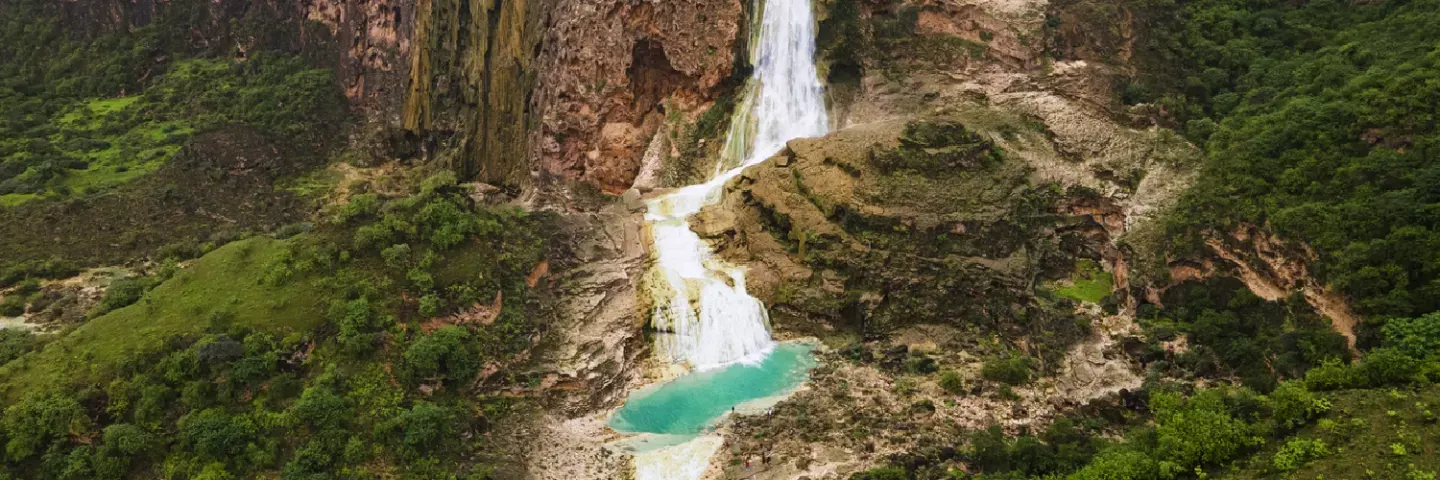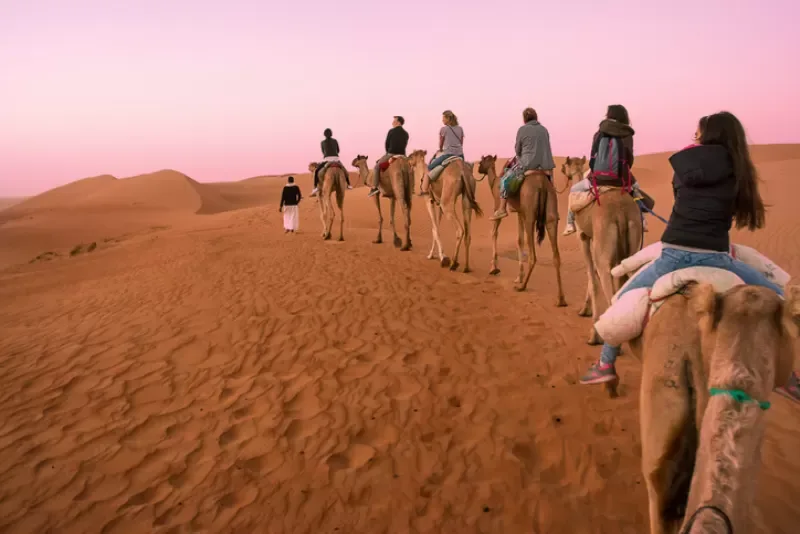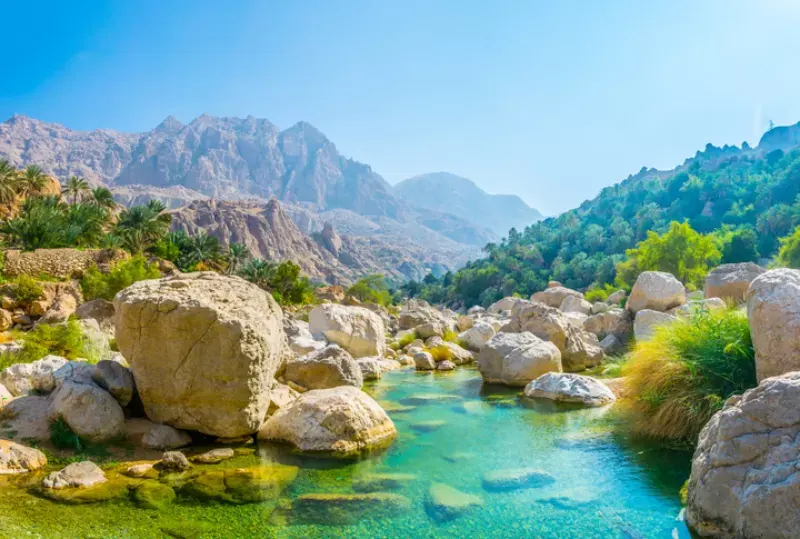The Best Nature of Oman Tours and Wildlife Enthusiasts

Oman presents a natural tapestry unlike any other in the Arabian Peninsula, boasting ecosystems of remarkable diversity and pristine beauty. The sultanate's geography unfolds dramatically from the imposing Al Hajar Mountains, which pierce the sky at heights exceeding 3,000 meters, to sweeping desert landscapes that stretch across 12,500 square kilometers of golden terrain. Nature enthusiasts find themselves captivated by extraordinary spectacles, endangered green turtles arriving nightly at Ras Al Jinz, where 50-60 mothers laboriously dig nests and deposit their precious eggs under moonlight. Birdwatchers marvel at the country's ornithological wealth, with over 500 species gracing Omani skies throughout the year.
The natural splendor of Oman manifests through starkly contrasting habitats. Beneath turquoise waters, vibrant coral gardens of the Daymaniyat Islands pulsate with marine life, while inland, the weathered grandeur of the Al Hajar range reveals millennia of geological history through its rugged contours and hidden valleys. Visitors traversing these landscapes might find themselves descending into ancient wadis, their footsteps echoing against canyon walls before plunging into crystal-clear oasis pools that have refreshed travelers for centuries. Along the coastline, pods of playful dolphins breach the warm Arabian Sea waters, creating ephemeral sculptures of glistening movement against the horizon. The country's natural tours unveil encounters with native fauna, alert mongoose scanning the underbrush, graceful gazelles bounding across plains, and kaleidoscopic fish species darting through underwater realms.
This detailed guide illuminates the most rewarding natural experiences awaiting discovery across this Arabian jewel. From camel-led journeys across rippling desert dunes to invigorating hikes along mountain ridges, from underwater explorations revealing marine treasures to peaceful observations at life-giving wetlands, each experience reflects Oman's profound dedication to environmental stewardship. The sultanate has pioneered conservation initiatives throughout its territories, ensuring these wonders remain pristine for generations of future explorers while allowing today's visitors intimate access to some of Earth's most captivating natural theaters.
Desert Adventures Oman for Nature Seekers
Oman's desert landscapes unfold as vast golden canvases stretching toward the horizon, offering nature enthusiasts extraordinary adventures beyond conventional exploration. These magnificent sandy realms create immersive experiences connecting visitors to both primordial natural wonders and the rich cultural heritage of Bedouin traditions passed through countless generations.
Camel trekking in Wahiba Sands
Wahiba Sands presents an oceanic expanse of undulating dunes that shift perpetually with desert winds, covering an impressive territory approximately 180 km long and 80 km wide. Camelback journeys across this majestic terrain provide perhaps the most authentic method to absorb the desert's fundamental character, following ancient pathways once vital to Omani commerce and cultural exchange.
Bedouin guides—masters of desert navigation—orchestrate treks ranging from brief one-hour excursions to elaborate multi-day expeditions that wind between towering dunes and isolated traditional settlements. Extended journeys invite travelers to experience nights beneath celestial canopies in authentic Bedouin encampments, where the aroma of traditional Arabic coffee brewing over smoldering charcoal fires mingles with evening desert breezes.
Particularly intrepid explorers might undertake the formidable North-South route—a challenging 150-kilometer odyssey requiring approximately seven days to complete. This remarkable passage commences at Al Raka village in the northern reaches and concludes near the Gulf of Oman, offering profound insights into the increasingly rare lifestyle of Omani Bedu communities whose ancestral knowledge of the desert spans countless generations.
Stargazing under the desert sky
Wahiba Sands provides ideal conditions for celestial observation due to minimal light pollution, a rarity in our increasingly illuminated world. As daylight surrenders to darkness, the heavens transform into a breathtaking astronomical theater, revealing stellar performances invisible from urban environments.
Knowledgeable astronomers conduct specialized stargazing expeditions equipped with sophisticated telescopes that unveil distant galaxies, luminous star clusters, and the magnificent sprawl of our Milky Way galaxy. These educational experiences decode the mysteries of constellations and cosmic phenomena while participants recline in comfort amid one of Oman's most spectacular natural settings.
The juxtaposition of experiences proves particularly memorable when stargazing accompanies overnight desert encampments. Witnessing the dramatic transformation from sun-drenched golden dunes to the profound darkness of night skies adorned with countless celestial bodies creates an impression that lingers long after departure.
Eco-camping in the Empty Quarter
The Empty Quarter, known locally as Rub Al Khali, represents the pinnacle of desert seclusion as the world's largest continuous sand desert. This remarkable landscape of flame-hued dunes envelops visitors in an atmosphere of otherworldly tranquility unmatched elsewhere in Arabia. The exclusive Empty Quarter Eco Lodge is a testament to sustainable luxury in extreme environments, accessible only via 4×4 vehicles traversing challenging terrain.
This exceptional accommodation features ten luxury tents with private terraces and two spacious bungalows, each appointed with private bathrooms, ensuring comfort amid wilderness. The property's filtered sulfur-water bathing lake merits special attention, offering therapeutic refreshment following desert explorations—a striking oasis amid seemingly endless arid expanses.
Evening hours bring diverse activities, including exhilarating 4×4 desert safaris, contemplative sunset expeditions, and cultural immersions within traditional Bedouin tents where authentic Arabic entertainment preserves ancient traditions. Despite severe environmental conditions, the region supports surprising biodiversity, including specialized endemic fauna such as the Arabian oryx and the uniquely adapted Rub Al Khali hare.
Travelers seeking more authentic desert experiences may opt for thoughtfully arranged wild camping expeditions. These expeditions provide essential comforts, including quality mattresses, practical furnishings, and uninterrupted views of majestic desert skies unhindered by artificial illumination—a window to the cosmos as witnessed by countless desert travelers throughout human history.

Mountain Escapes in Oman's Highlands
The majestic Al Hajar Mountains rise like ancient sentinels from Oman's eastern terrain, their jagged silhouettes creating a dramatic counterpoint to the sultanate's golden deserts. These formidable highlands offer nature enthusiasts a welcome thermal reprieve, with temperatures often registering 10-15 degrees cooler than coastal regions. Verdant pockets nestled within otherwise austere rock faces harbor ecological treasures that reward those willing to venture into these elevated realms.
Trekking Jebel Akhdar and Jebel Shams
Jebel Akhdar, aptly named the Green Mountain, stands as a limestone fortress reaching 2,000 meters skyward. Its distinctive terraced agricultural systems transform otherwise barren slopes into cascading gardens where pomegranate trees flourish alongside celebrated damask roses. These delicate blooms, harvested during April's dawn hours, yield precious rose water through distillation methods unchanged for generations. Adventurous souls traverse the mountain's famed Balcony Walk, treading carefully along ancient pathways once traveled by sure-footed donkeys laden with mountain harvests. The trail clings precariously to sheer cliff edges, rewarding hikers with breathtaking panoramas of vast wadis carved deep into the mountain's heart.
Jebel Shams, the Mountain of Sun, commands respect as Oman's supreme peak at 3,009 meters. Dawn visitors witness the Arabian Peninsula's first sunlight caressing its weathered summit before illuminating what locals reverently call "Oman's Grand Canyon." Wadi Ghul plummets vertically for more than 1,000 meters, creating a geological spectacle where millennia of patient erosion have sculpted stratified walls revealing Earth's ancient past. The popular rim trail skirts this magnificent abyss, offering heart-racing vistas while remaining accessible to reasonably fit walkers who maintain appropriate caution near precipitous edges.
Exploring traditional mountain villages
Ancient stone settlements punctuate the Al Hajar range, each representing human ingenuity in adapting to demanding mountain environments. Misfat Al Abriyeen exemplifies these remarkable communities, its mud-brick dwellings seemingly growing organically from rocky promontories. Narrow stone pathways wind between multi-story structures built centuries before modern construction techniques arrived in Oman. The village's lifeblood flows through meticulously maintained falaj channels—an indigenous irrigation system recognized by UNESCO for its engineering brilliance—directing precious mountain water to terraced gardens where walnut trees spread protective canopies over delicate crops.
Al Hamra village preserves architectural heritage dating back four centuries, its mud homes standing as a testament to traditional building wisdom perfectly suited to the mountain climate. Further into the highlands, Bilad Sayt emerges like a mirage after navigating hair-raising mountain roads accessible only by four-wheel drive vehicles. This remote hamlet presents an almost theatrical perfection, its stone houses clustered protectively around fertile plots where residents maintain agricultural traditions despite their geographical isolation.
Wildlife spotting in Al Hajar range
The seemingly inhospitable terrain of the Al Hajar mountains shelters remarkable biodiversity, much of it specially adapted to these unique conditions. Patient observers might glimpse the Arabian tahr—an endangered wild goat species that navigates precipitous slopes with astonishing surety of foot. These rare creatures, found nowhere else on Earth, represent a conservation priority for Omani authorities working to protect critical habitat from human encroachment.
The mountain air carries the distinctive calls of Egyptian vultures as they ride thermal currents high above the peaks. These magnificent birds, instantly recognizable by their wedge-shaped tails and distinctive white plumage, share the skies with imposing lappet-faced vultures whose massive wingspans can exceed 2.5 meters. Birdwatchers rise before dawn, knowing the first light brings mountain wildlife into momentary visibility before the heat of day drives creatures into protective shade. Success demands patience, silence, and quality optical equipment—rewards come to those who develop the naturalist's art of stillness, allowing the mountain to reveal its secrets in its own time.

Customize Your Dream Vacation!
Get in touch with our local experts for an unforgettable journey.
Plan Your TripMarine Life and Coastal Wonders
Oman cradles a magnificent coastline extending over 3,000 kilometers, where the aquamarine waters of the Arabian Sea merge with the deep blue expanse of the Indian Ocean. This maritime frontier constitutes a natural sanctuary whose biodiversity rivals the country's terrestrial splendors. Beneath the surface, vibrant coral gardens, mysterious shipwrecks, and ancient underwater formations create habitats for thousands of marine species, drawing wildlife enthusiasts from across the globe to witness this submerged paradise.
Snorkeling at Daymaniyat Islands
The Daymaniyat archipelago, designated as a nature reserve since 1996, represents the crown jewel of Oman's marine environments. These islands harbor marine life concentrations that astound even seasoned underwater explorers—divers frequently document encounters with up to 26 turtles and 12 sharks visible simultaneously within a single location. Crystal visibility extends for dozens of meters, revealing green turtles gliding effortlessly through azure depths, blacktip reef sharks patrolling coral territories, and kaleidoscopic fish species, including the striking Arabian butterflyfish, vibrant red sea clownfish, and the distinctively patterned daisy parrotfish.
Summer months between July and October usher in opportunities to encounter the ocean's gentle giants—whale sharks—whose massive spotted forms materialize from the blue depths, drawing nature enthusiasts during this prime viewing season. These islands serve dual ecological purposes, functioning not only as marine sanctuaries but also as crucial nesting grounds for migratory birds. This remarkable convergence creates a truly integrated ecosystem where winged visitors from distant continents share protected habitat with ancient marine reptiles, each playing vital roles in this delicately balanced natural theater.
Dolphin and whale watching near Muscat
Nutrient-rich upwellings along Oman's coastline support extraordinary cetacean diversity, including resident populations of bottlenose, spinner, and common dolphins. These intelligent mammals frequently approach vessels with apparent curiosity, engaging in spectacular acrobatic performances mere meters from astonished onlookers. Spinner dolphins particularly delight observers with their signature aerial rotations—powerful leaps culminating in multiple twisting turns before gracefully slicing back into the water.
Maritime excursions depart daily from Muscat's harbors, with experienced captains navigating to known dolphin territories during journeys typically spanning 2-3 hours. Generations of these marine mammals have grown accustomed to respectful boat traffic, often choosing to investigate vessels and ride bow waves created by their passage. Beyond these regular sightings, fortunate visitors occasionally witness more elusive cetaceans—the distinctive black and white patterns of killer whales, the massive flukes of humpbacks, or even the distinctive angular spouts of sperm whales navigating the deeper waters of the Gulf of Oman.
Turtle nesting at Ras Al Jinz
Ras Al Jinz Turtle Reserve guards one of nature's most ancient and moving spectacles. This protected eastern promontory welcomes approximately 30,000 female green turtles annually, each driven by a primal instinct to return to their natal beaches. Scientific studies confirm this stretch of coastline ranks among the Indian Ocean's most significant rookeries for these endangered marine reptiles, whose ancestral nesting behaviors remain largely unchanged for millions of years.
Guided evening excursions allow visitors privileged glimpses into this ancient ritual—the laborious ascent from surf to dry sand, the careful excavation of nest chambers, and the trance-like state that envelops mothers during egg deposition. Morning tours reveal different wonders—tiny hatchlings emerging from their sandy incubators, orienting themselves by the reflected light of the ocean, and beginning their perilous dash toward the waiting waves. This remarkable cycle reaches its zenith during the summer months of May through September, with July through September witnessing the most concentrated nesting activity. Visitors fortunate enough to witness these events often describe them as among life's most profound natural encounters—ancient reptiles fulfilling biological imperatives established long before human civilization emerged.

Wadis, Wetlands, and Wildlife Reserves
Beyond the commanding peaks and coastal panoramas of Oman lie hidden treasures of freshwater sanctuaries and meticulously protected reserves. These inland havens reveal yet another facet of the sultanate's natural heritage—verdant oases cradled within stark geological formations, wetlands teeming with avian diversity, and designated sanctuaries preserving Oman's most vulnerable species.
Swimming in Wadi Bani Khalid and Wadi Tiwi
Wadi Bani Khalid reigns as perhaps the most generously accessible of Oman's water-carved valleys, offering visitors emerald-hued pools merely five-minute' stroll from designated parking areas. The wadi's allure lies partially in its thermal character—natural hot springs feed these inviting waters, maintaining comfortable swimming temperatures regardless of season. Adventurers seeking further exploration might venture a kilometer beyond the main pools to discover Muqal Cave, where mineral-rich waters emerge from deep within the earth to nourish the wadi's renowned bathing spots.
The lesser-frequented Wadi Tiwi presents a more intimate communion with nature's artistry. Here, nature has sculpted a masterpiece of towering canyon walls, pools of crystalline clarity, and the captivating cascade known as Mibam waterfall. Navigation through this natural corridor demands moderate physical prowess, as visitors must negotiate sections requiring both swimming through deep, sun-dappled pools and careful traversal across diminutive waterfalls. Most captivating among Tiwi's features stands an expansive pool embraced by sheer rock faces adorned with fern-like vegetation—an ancient tableau reminiscent of prehistoric landscapes.
Birdwatching at Al Ansab Wetland
Al Ansab Wetland functions as a critical avian sanctuary, harboring an extraordinary diversity of more than 300 bird species. This ecological haven has garnered international acclaim as one of the sultanate's preeminent wildlife refuges. The wetland's significance magnifies through its role as a vital migratory corridor, where seasonal avian movements follow ancient patterns dictated by climate and breeding cycles.
Among its distinguished residents, observers might glimpse the endangered Egyptian vulture soaring on thermal currents alongside the majestic steppe eagle. The vulnerable common pochard and sooty falcon similarly find refuge within these protective boundaries. Al Ansab's ecological significance transcends its avian population—these waters sustain over 100 varieties of indigenous Omani flora, while the entire ecosystem plays a substantial role in regional climate regulation efforts.
Discovering animals in Oman's protected areas
The sultanate's dedication to wildlife preservation manifests through an elaborate network of nature reserves encompassing nearly 30,000 square kilometers of territory. These designated sanctuaries safeguard critical habitats ranging from coastal ecosystems to alpine environments and arid desert expanses.
Particularly noteworthy among these protected zones stands the Arabian Oryx Sanctuary in Al Wusta. This expansive reserve provides essential breeding territory for several threatened species, including the emblematic Arabian Oryx, the nimble Nubian Ibex, and perhaps most precious of all, the vanishingly rare Arabian Leopard. Complementing these inland conservation efforts, coastal preserves extending from Ras Al Hadd to Masirah Island offer sanctuary to green turtles engaged in their ancient reproductive ritual—females returning with unerring precision to deposit eggs upon the very shores where they emerged decades earlier.

Conclusion
Oman emerges as a sanctuary for wildlife enthusiasts yearning for authentic natural encounters amid astonishingly varied landscapes. This Arabian peninsula kingdom unfolds its natural wonders with remarkable generosity—golden dunes of Wahiba Sands traversed by swaying camel caravans stand in magnificent contrast to the nesting beaches of Ras Al Jinz, where endangered green turtles perform their ancient reproductive rituals beneath starlit skies.
The sultanate's dedication to ecological preservation manifests through an impressive network of protected territories encompassing nearly 30,000 square kilometers. These carefully managed sanctuaries shield vital ecosystems while simultaneously offering privileged glimpses of elusive creatures—the stately Arabian oryx with its rapier-straight horns and the secretive Arabian leopard padding silently through remote mountain passes.
Aquatic enthusiasts discover equal measures of delight beneath Omani waters. The Daymaniyat Islands present kaleidoscopic coral gardens where multicolored fish dart between formations while green turtles glide overhead with prehistoric grace. Inland, the emerald pools of Wadi Bani Khalid offer refreshing respite from desert journeys, their mineral-rich waters cradled by weathered limestone cliffs. Highland explorers find themselves traversing the breathtaking terrain of Jebel Akhdar and Jebel Shams, where terraced agricultural communities have maintained traditional lifeways for countless generations, their stone dwellings seemingly growing from the very mountainsides.
Thoughtful planning enhances any Omani natural expedition. The turtle nesting phenomenon reaches its zenith between July and September, while winter's milder temperatures create ideal conditions for desert explorations. Regardless of seasonal timing, knowledgeable local guides profoundly enrich these experiences, sharing insights garnered through generations of intimate connection with these landscapes.
The natural treasures of Oman offer far more than mere visual splendor or wildlife observation—they provide cultural bridges spanning centuries of human adaptation to challenging environments. The sultanate presents a harmonious convergence of adventure, serenity, and biological richness that speaks directly to those who cherish our natural world. Here awaits a realm where conservation practices, traditional knowledge systems, and natural beauty coexist in exemplary balance, inviting mindful exploration while ensuring these wonders endure for generations yet unborn.
Ready to experience Oman's breathtaking natural wonders and diverse wildlife? Book your Oman travel packages today and embark on an unforgettable adventure!
The best times depend on your interests. For turtle nesting, visit between July and September. Winter months are ideal for desert exploration. Dolphin watching is possible year-round, while bird watching is excellent during migratory seasons in spring and fall.
Yes, Oman's protected areas offer opportunities to spot rare species. The Arabian Oryx Sanctuary houses endangered Arabian Oryx and Nubian Ibex. You might also glimpse the elusive Arabian Leopard or the endangered Egyptian Vulture in certain reserves.
Snorkeling in places like the Daymaniyat Islands offers chances to see green turtles, blacktip reef sharks, and colorful fish such as Arabian butterflyfish and red sea clownfish. Lucky visitors might even encounter whale sharks between July and October.
Absolutely. Many guided tours are available, including camel trekking in Wahiba Sands, stargazing expeditions in the desert, dolphin watching near Muscat, and turtle nesting tours at Ras Al Jinz. Local guides often provide valuable insights about wildlife and ecosystems.
Oman offers diverse landscapes, including vast deserts like Wahiba Sands and the Empty Quarter, dramatic mountains in the Al Hajar range, pristine beaches along its 3,000 km coastline, and refreshing wadis such as Wadi Bani Khalid and Wadi Tiwi. Each offers unique flora, fauna, and geological features.
Related Articles
Keep the inspiration going with these handpicked travel reads.
